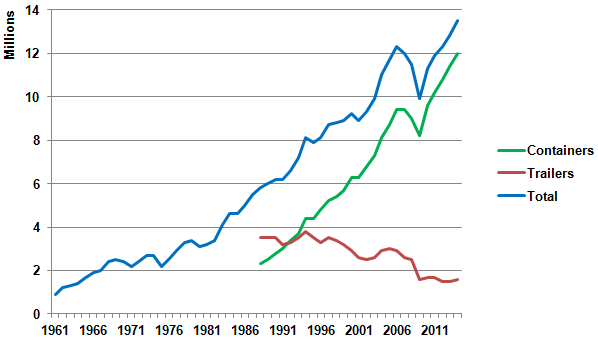Uncrossable Desert
In January 1978, G.A. Kellow offered this report on the Milwaukee's plant rationalization efforts as it moved into its final bankruptcy [1]:
Traffic patterns over the past 30 years, and probably longer, show that the total transcontinental rail market is not a strong growth market; that the Milwaukee Road's share has always been small; and that the share of the market is in fact diminishing.
Given the small present market share, the strong rail competition and the apparent limited total market, the Milwaukee Road cannot expect to increase its share of the traffic enough in the future to justify maintaining transcontinental service.
On the basis of this study and analysis, the following conclusions are drawn:
- The railroad probably should not have extended its line to the Pacific Northwest at the time it was done.
- There is no economic justification in continuing transcontinental service to the West Coast.
- A long-range objective should be to phase out most, if not all, operations west of Miles City (a difficult assignment).
Now with the advantage of hindsight, it's interesting to note that though the long range objective was achieved and the track removed, some of the predictions were not [2 with data from AAR]:
Many have noted that the line planted by the Milwaukee Road over 100 years ago avoided many of the population centers of the day. Perhaps, in some final irony, that reduced congestion would play even better with the long haul intermodal traffic that has sprung to life so distinctly in the decades since the railroad's departure.
In the image above, the Milwaukee's mainline is taking dead aim at Vendome, MT and the pass over the Rocky Mountains. In the rain shadow of this high desert area, an impending storm gives the promise of rain for these barren heights. But as the years accumulate and the memories of what was slide faithfully away like a mist in the morning sun, this high desert becomes one that no one can cross. And as with all great mysteries, who can explain this?
References:
1)Kellow, "Rationalization of
the Plant: Study of the Line between Miles City, MT and Portland, OR" 1978. https://www.milwaukeeroadarchives.com/EconomicStudies/EconomicStudies.htm
2)"Freight Railroad Traffic & Intermodal Volumes (1890 - Present)
https://www.railserve.com/stats_records/freight_railroad_traffic_volumes.html





Comments
The combination of the BAH Report and Recommendations, and Hillman's reaction, clearly show that Hillman had been misled about the status of the railroad, and was none too happy about it, and none too happy with Cruikshank, who had been energetically participating in the reorganization planning, while Smith struggled with the day-to-day challenges of keeping the railroad running. Cruikshank was such a strong personality, and overbearing in his opinions, that Marty Garelick quit the Milwaukee, one of its most talented executive officers (VP Operations at that point) rather than continue to work with Paul Cruikshank. "You don't treat people the way he did," Marty told me.
With Hillman gone, the new Trustee, former Trustee Counsel Richard Ogilvee became Trustee. Ogilvie knew nothing of railroading, and was dependent on Cruiskhank (and Smith) for guidance. That was the end of Lines West as Cruikshank, for whatever reasons, had a deep personal animosity to Lines West. The BAH study was ignored and the viable options discounted in favor of near certain failure or at least extreme difficulty.
The most likely proposed successful configuration of a reorganized Milwaukee Road was the one chosen by NewMil as the proposed reorganization plan. That plan was rejected by the ICC based on the ICC's brand new criteria that a reorganization proposal needed to show a rate of return of at least 10% or so, something that only one solvent railroad in the country was meeting at the time.
Ironically, then, the Trustee's plan was also rejected, but since the Trustee was already in charge, he won by default. A system configuration judged by the outside professionals to be among the least successful probabilities of survival won. By default.
http://www.milwaukeeroadarchives.com/Bankruptcy/StrategicPlanningStudiesVol2.pdf